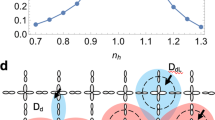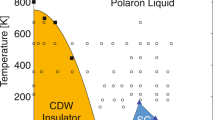Summary
To accommodate the number of holes and fractional number of atoms in doped highT c superconductors, and to produce a periodic structure with given symmetry, we postulate a quadruple cell with four copper atoms on the CuO2 layer. The quadruple cell structure hasD 2h symmetry which can be distorted toC 2h geometry underB 1g vibration. Such a structure allows the interconversion of different spin angular momenta into paired spins similar to Cooper pairs. It also provides vibronic interactions that lower the energy of the ground state. For electron (hole) pairing, we construct the running wave Bloch sums consisting of linear combination of bonding/antibonding geminals (instead of one-electron atomic orbitals) in these quadruple cells. For “bond” movement we construct the Bloch sums consisting of linear combination of “Covalon” waves in quadruple cells related to the movement of conjugate (alternating) bonds. In both cases the pair-wise charge (hole/electron) transfer is coupled with antisymmetric vibrations under a double-well potential related to Peierls distortion. The vibronic mixing of different running bonds with different antisymmetric vibrations at various distances, accounts for the different long-range order of charge transfer. Our formulations represent an alternative view of BCS theory, Bisoliton theory and Resonanting Valence Bond theory by using a quantum chemical, position-space approach to a more tight binding situation.
Similar content being viewed by others
References
Bednorz JG, Mueller KA (1986) Z Phys B64:189
Poole Jr CP, Datta T, Farach HA (1988) Copper oxide superconductors. Wiley, New York
Phillips JC (1989) Physics of highT c superconductors. Academic Press, New York
Rao CNR, Raveau B (1989) Account Chem Res 22:106
Bardeen J, Cooper LN, Schrieffer JR (1957) Phys Rev 106:162; 108:1175
Kittel C (1963) Quantum theory of solids. Wiley, New York
Rose-Innes AC, Rhoderick EH (1978) Introduction to superconductivity. Pergaman, Oxford
Tinkham M (1975) Introduction to superconductivity. R. F. Krieger, Malabar, Florida
Schrieffer JR (1983) Theory of superconductivity. Addison-Wesley, New York
Cohen RE, Pickett WE, Krakauer H (1989) Phys Rev Lett 62:831 (1990) 64:2575
Hybertsen MS, Stechel EB, Schluter M, Jennison DR (1990) Phys Rev B41:11068
Cava RJ (1990) Science 247:656
Whangbo M-H, Torardi CC (1991) Accounts Chem Res 24:127
Chiu YN (1989) J Chin Chem Soc 36:487; (1989); (1993) European J Solid State Inorg Chem T30:1119
Tokura Y, Takagi H, Uchida S (1989) Nature 337:345
Birgeneau RJ (1990) Am J Phys 58:28
Whangbo M-H, Evain M, Beno MA, Geiser U, Williams JM (1987) Inorg Chem 26:2566; 26:1829
Chiu YN (1972) J Chem Phys 56:4882
Brodsky MB (1991) MRS Bulletin P31
Tinkham M (1964) Group theory and quantum mechanics. McGraw-Hill, New York.
Chiu YN (1979) Phys Rev A20:32 and references cited therein
Chiu YN, Meiling Gong (1990) Chem Phys 145:397
Herzberg G (1966) Electronic spectra and electronic structure of polyatomic molecules. D. Van Nostrand, Princeton, NJ
Chiu YN (1984) J Phys Chem 88:5820
Alexandrov AS, Ranninger J (1981) Phys Rev B23:1796
Alexandrov AS, Ranninger J, Robaszkiewicz S (1986) Phys Rev B33:4526
Alexandrov AS (1988) Phys Rev B38:925
Stavola M, Krol DM, Weber W, Sunshine SA, Jayarama A, Kouroukis GA, Cava RJ, Rietman EA (1987) Phys Rev B36:850
Clougherty DP, Johnson KH McHenry ME (1989) Physica C 162–164:1475
Johnson KH, Clougherty DP, McHenry ME (1989) Modern Phys Lett 3:1367 (1991); In: Ashkeazi et al. (eds) High-temperature superconductivity. Plenum Press, New York, p 341
Wang FE, Chiu YN (1976) Chem Phys 12:225; YN Chiu, FE Wang (1976) Chem Phys 18:301
Chiu YN, Wang FE (1982) J Solid State Chem 45:353; (1982) Inorg Chem 21:4264
Hook JR, Hall HE (1991) Solid state physics. Wiley New York
Christman JR (1988) Fundamentals of solid state physics. Wiley, New York
Davydov AS (1988) Phys Stat Sol (b) 146:619; (1990) Phys Reports 190:191
Davydov AS, Ermakov VN (1988) Phys Stat Sol (b) 148:305
Craig DP, Walmsley SA (1968) Excitons in molecular crystals. Benjamen, New York
Hochstrasser RM (1966) Ann Rev Phys Chem. 17:457
Robinson GW (1970) Ann Rev Phys Chem 21:429
Davydov AS (1962) Theory of molecular excitons. McGraw-Hill, New York
Chiu YN (1976) J Phys Chem 80:992
Bell RP (1980) The tunnel effect in chemistry. Chapman and Hall, London
Marcus RA, Sutin N (1985) Biochimica et Biophysica Acta 811:265
Chiu YN (1976) J Chem Phys 64:2997; Chiu YN, Friedrich B, Maring W, Niedner G, Noll M, Toennies JP (1988) J Chem Phys 88:6814
Anderson PW (1987) Science 235:1196
Anderson PW, Baskaran G, Zou Z, Hsu T (1987) Phys Rev Lett 38:2790
Lynn JW (ed) (1990) High temperature superconductors. Springer, New York
Burns G (1982) High temperature superconductivity. Academic Press, New York
Author information
Authors and Affiliations
Rights and permissions
About this article
Cite this article
Chiu, YN., Brown, S.H., Sondergaard, N. et al. Vibronic pairwise charge transfer in copper-oxide sheets: A possible approach to high temperature superconductivity theory. Theoret. Chim. Acta 90, 205–224 (1995). https://doi.org/10.1007/BF01113469
Received:
Accepted:
Issue Date:
DOI: https://doi.org/10.1007/BF01113469




